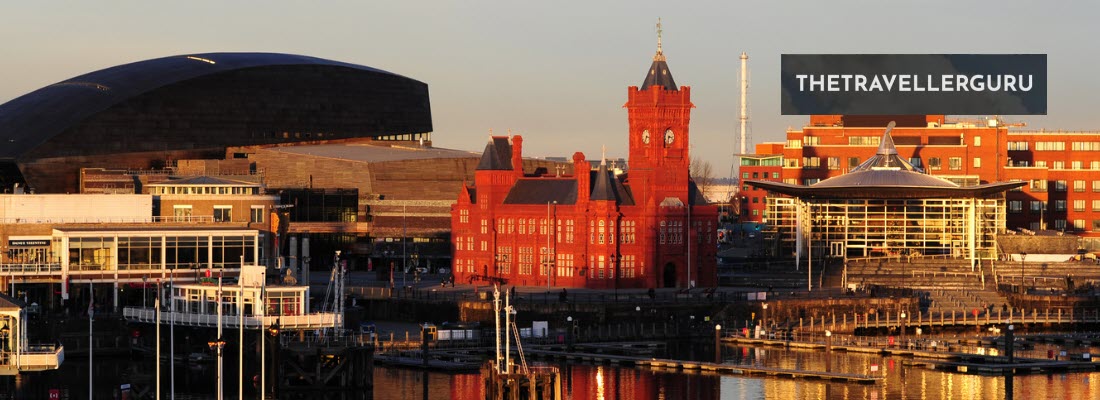Hey there fellow travelers and welcome to my post where we will cover 10 ways to spend one day in Rome. Now, we all know the joys that travel can bring, from visiting far off places, experiencing different cultures and of course, all the new foods. But there is also a downside, – that dreaded day to ‘waste’ in a city whilst waiting for a midnight flight.
So if you are like me (as I live in Australia, all outgoing flights seems to leave late at night), there has been many a day where you need to find something to do that is enjoyable, but doesn’t take too much time – or cost too much money. So if you have a day to kill in Rome, here are 10 things you can do to pass the time in an enjoyable way.
Let’s check them out…
- Explore the Vatican Museums
- Climb the Spanish Steps
- Try your luck at the Trevi Fountain
- Wander through the Pantheon
- Enjoy the Piazza Navona
- Drop by Largo di Torre Argentina
- Head over to Piazza Venezia
- Visit the Colosseum
- Enjoy the views at Vittorio Emanuele Monument
- Spend some time at Teatro Marcello
How to Spend One Day in Rome
Rome is home to many iconic landmarks, including the Colosseum, the Roman Forum and the Pantheon, all remnants of the city’s past as the capital of the Roman Empire. Then of course there is the Vatican City, an independent city-state enclaved within Rome and is the spiritual and administrative headquarters of the Roman Catholic Church.
So to help you out, here are 10 unforgettable ways to spend a day in Rome, ensuring that your visit to this enchanting city is nothing short of magical.
Check out these: 10 Ways to Spend One Day in Paris
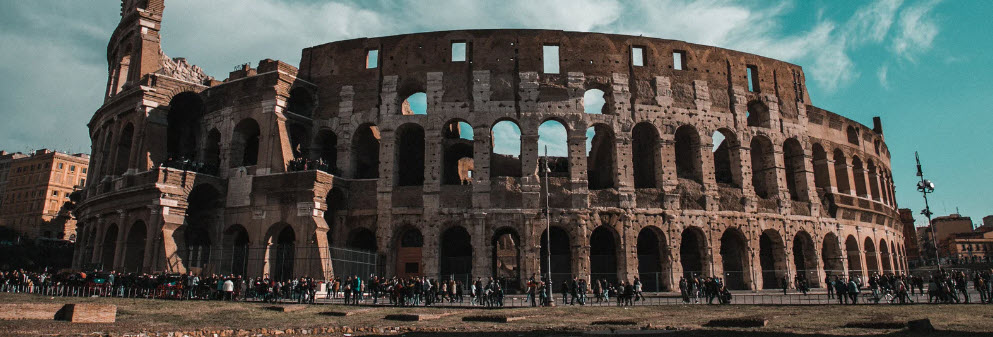
1. Explore the Vatican Museums

The Vatican Museums, nestled within the Vatican City, are an absolute must-visit for art enthusiasts and history buffs. This sprawling complex houses a remarkable collection of artistic treasures, ranging from ancient artifacts to Renaissance masterpieces.
Embarking on a journey through the Vatican Museums is akin to stepping into a time capsule of artistic brilliance. Each room and corridor reveals a new marvel, drawing you deeper into the rich tapestry of human creativity. From awe-inspiring sculptures to breathtaking frescoes, the museums offer a sensory feast that will leave you in awe.
Begin your tour in the early morning so you’ll have the chance to savor the masterpieces at your own pace, reveling in their beauty without the usual crowds. Your knowledgeable guide will provide insightful commentary, shedding light on the historical context and artistic significance of each piece.
To make the most of your visit to the Vatican Museums and avoid the long lines, a valuable tip is to book an early access Vatican tour with an art history expert. This exclusive opportunity allows you to enter the museums an entire hour before the general public, granting you precious moments of tranquility and uninterrupted exploration.
As you make your way through the museums, the highlight of your early access experience awaits—the breathtaking Sistine Chapel. With its world-renowned ceiling frescoes by Michelangelo and the mesmerizing Last Judgment adorning the altar wall, the chapel is an undeniable masterpiece that must not be missed.
After the Sistine Chapel, your early access tour will lead you directly to St. Peter’s Basilica, the spiritual heart of the Vatican. Here, you can marvel at the grandeur of the largest church in the world, adorned with priceless works of art, including Michelangelo’s iconic sculpture, the Pietà.
Vatican Museum
Location: Viale Vaticano, 100, Roma 00192
2. Climb the Spanish Steps
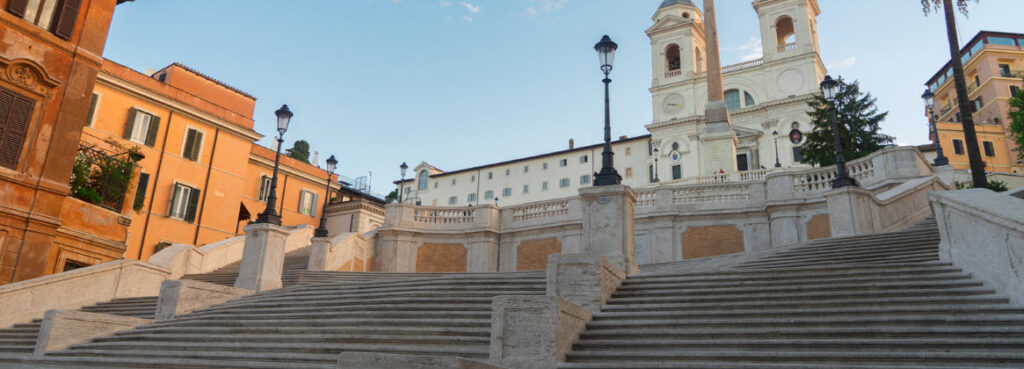
The Spanish Steps, known as “Scalinata di Trinità dei Monti” in Italian, are a picturesque and iconic landmark in Rome. Located in the heart of the city, these grand staircases connect the Piazza di Spagna at the base with the Trinità dei Monti Church at the top, offering visitors breathtaking views and a perfect spot for people-watching.
The Spanish Steps have long been a popular meeting point and gathering place for both locals and tourists alike. The 135 steps attract visitors from around the world, who come to marvel at the elegant design and soak in the vibrant atmosphere of this bustling area.
The stairs are directly in front of Via Condotti, a world-renowned street known for its luxury and haute couture brands. If you’re in the mood for some high-end shopping, this is the perfect destination to indulge your fashion desires. From renowned Italian designers to international fashion houses, you’ll find a wide range of upscale boutiques and flagship stores along this prestigious street.
And when you need a break, grabbing a quick lunch is a popular option, and we highly recommend trying pizza al taglio, which is pizza sold by the slice. Rome is famous for its mouthwatering pizza, and this quick and convenient option allows you to sample different flavors and toppings while on the go.
Spanish Steps
Location: Piazza di Spagna, 00187 Roma
3. Try your luck at the Trevi Fountain
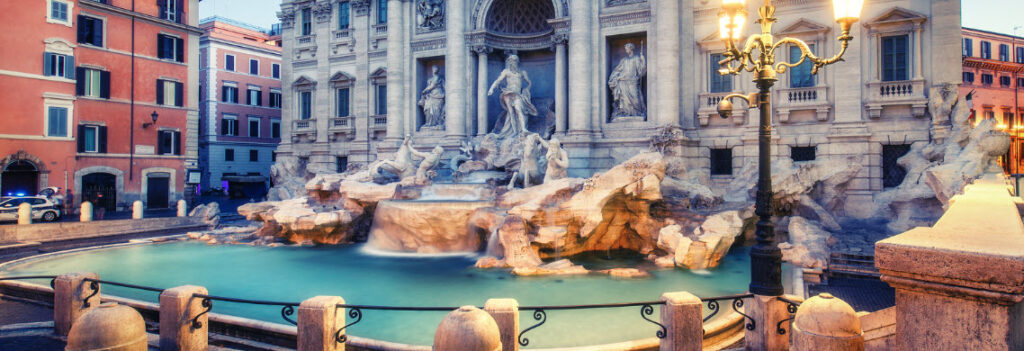
One of the most iconic and enchanting landmarks in Rome, the Trevi Fountain, or “Fontana di Trevi”, is a must-visit destination for anyone exploring the city. Known worldwide for its beauty and allure, the Trevi Fountain attracts millions of visitors each year who come to admire its grandeur and partake in a beloved tradition.
Situated in the heart of Rome, the Trevi Fountain is a true masterpiece of Baroque architecture with intricate designs that feature a magnificent sculpture of Neptune, the Roman god of the sea, surrounded by cascading waterfalls and mythical sea creatures. The fountain’s grandeur and attention to detail make it a truly captivating sight to behold.
One of the most popular activities at the Trevi Fountain is to try your luck by tossing a coin into the water. According to legend, if you throw a coin over your left shoulder using your right hand, it ensures your return to Rome. This tradition has become a symbolic gesture for visitors, symbolizing a desire to return to the Eternal City someday.
While the Trevi Fountain is undoubtedly a sight to behold, it’s also worth exploring the surrounding area. Take a stroll through the narrow streets where you’ll find a delightful mix of shops, cafes, and gelato stands. You can also enjoy a leisurely meal at one of the many nearby restaurants, soaking in the atmosphere and savoring the flavors of Italian cuisine.
Trevi Fountain
Location: Piazza di Trevi, 00187 Roma RM, Italy
4. Wander through the Pantheon
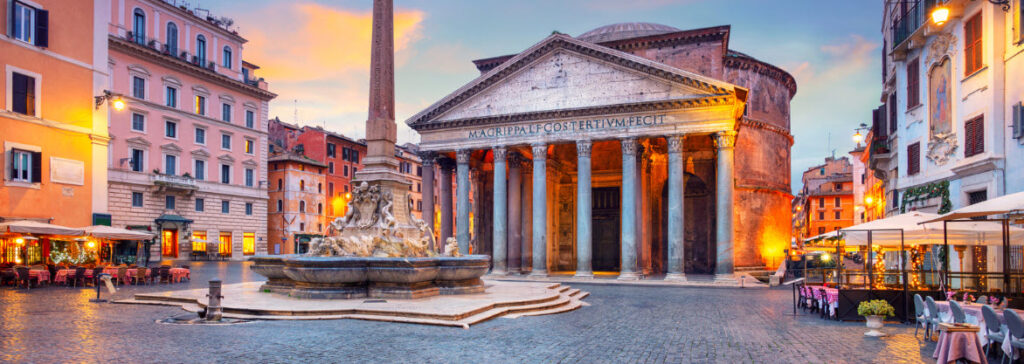
Located just a short five-minute walk from the iconic Trevi Fountain, the Pantheon is a remarkable ancient structure that stands as one of Rome’s greatest architectural marvels. Dating back to the second century A.D. and commissioned by the esteemed Emperor Hadrian, the Pantheon is a testament to the grandeur and engineering prowess of the Roman Empire.
The Pantheon is renowned for its impressive dome, which is considered by many scholars to be the best-preserved structure from antiquity. The dome’s architectural brilliance lies in its innovative design, featuring a massive concrete dome with a central oculus, and an open circular opening at the top that allows natural light to flood the interior. This architectural feat creates a mesmerizing interplay of light and shadow, adding to the Pantheon’s ethereal atmosphere.
Stepping inside the Pantheon is similar to entering into an ancient timeline. The spacious interior reveals a stunning rotunda with soaring columns and a perfectly proportioned dome above. As you explore the grandeur of this ancient temple, you’ll also discover that the Pantheon serves as the final resting place for some of Italy’s most iconic figures. Among the tombs housed within its hallowed walls are those of renowned painter Raphael and King Victor Emmanuel II, the first king of unified Italy.
Pantheon
Location: Piazza della Rotonda, 00186 Roma RM, Italy
5. Enjoy the Piazza Navona

Piazza Navona, one of Rome’s most stunning and renowned squares, is a must-visit destination for anyone exploring the city. This square, with its unique elongated shape, holds a fascinating history that dates back to ancient times.
Originally commissioned by Emperor Domitian in 86 CE, Piazza Navona was once the site of a grand stadium known as Circus Agonalis. The stadium had stands capable of accommodating an impressive 20,000 spectators and was used for various athletic competitions. During the summer months, Pope Innocent organized spectacular “water games” where the entire square was transformed into a water-filled spectacle.
In the 17th century, several magnificent buildings were added to the square. Pope Innocent X played a significant role in the transformation of Piazza Navona by commissioning the construction of Sant’Agnese in Agone, a splendid church, and a palace. Additionally, he enlisted the renowned sculptor and architect Gian Lorenzo Bernini to create the magnificent Fountain of the Four Rivers, known as La Fontana dei Quattro Fiumi.
Visitors to Piazza Navona can also explore the fascinating excavations located five meters below street level. These excavations offer a glimpse into the original Stadio di Domiziano or the Stadium of Domitian. Open to the public daily from 10 am to 7 pm, these archaeological wonders provide an opportunity to delve into Rome’s rich history. A ticket to the excavations costs €9, and a guided audio tour lasts approximately 40 minutes.
Piazza Navona
Location: 00186 Roma RM, Italy
6. Drop by Largo di Torre Argentina

Nestled in the heart of Rome, between the city’s ghetto and the famous Pantheon, Largo di Torre Argentina holds immense historical significance as it is the very place where Julius Caesar met his tragic fate on the Ides of March in 44 BC. This event forever etched the square into the annals of history.
Not only is Largo di Torre Argentina an archaeological treasure, but it is also renowned as the home of Rome’s Cat Sanctuary. Cat lovers from around the world are drawn to this square, where they can visit and interact with the resident feline population. The Cat Sanctuary provides a haven for abandoned and stray cats, making Largo di Torre Argentina a beloved destination for animal enthusiasts.
While the square’s historical and feline associations are well-known, it is often overshadowed by other tourist attractions however, recent developments have made Largo di Torre Argentina even more appealing. The square now boasts a newly opened archaeological area, allowing visitors to explore its rich history in greater detail providing a unique opportunity to witness the ancient ruins that lie several meters below the current street level.
Beyond its archaeological allure, Largo di Torre Argentina also houses Teatro Argentina, a theater that adds to the cultural significance of the square and hosts various performances, ranging from classic plays to contemporary productions, attracting theater enthusiasts from near and far.
Piazza Navona
Location: 00186 Roma RM, Italy
7. Head over to Piazza Venezia
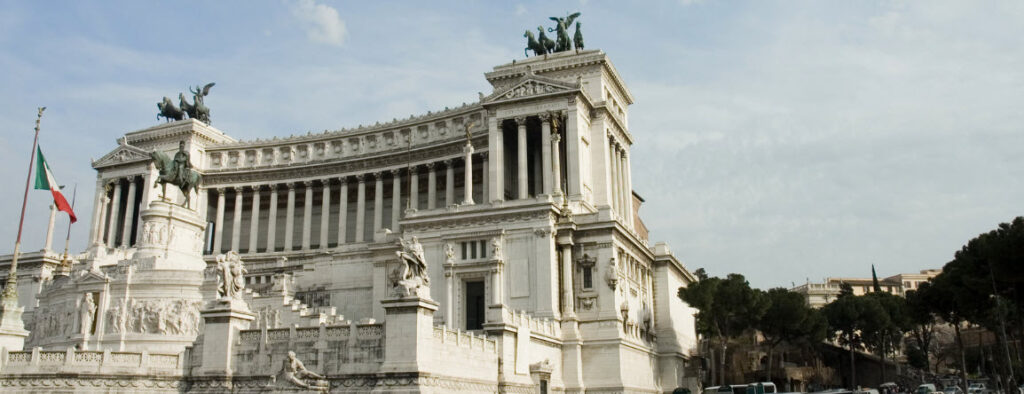
As you make your way from Largo Argentina towards the magnificent Colosseum, a stop at Piazza Venezia is well worth the effort. Situated in the heart of Rome, this bustling square serves as the city’s central hub and offers a captivating blend of historical landmarks and grandeur.
Constructed between 1455 and 1464 by Venetian Cardinal Pietro Barbo, the piazza holds the distinction of being the oldest building still standing in the square. Originally built as a papal palace for Cardinal Barbo, who ascended to become Pope Paul II, it eventually served as the Republic of Venice’s embassy.
The palace’s historical journey continued as it came under the ownership of the Italian government during World War I and eventually fell into the hands of the fascist dictator Benito Mussolini. Presently, the palace is home to the Museo Nazionale di Palazzo Venezia, where visitors can delve into the artistic treasures of the Medieval and Renaissance eras.
Piazza Venezia
Location: 00187 Roma RM, Italy
8. Visit the Colosseum
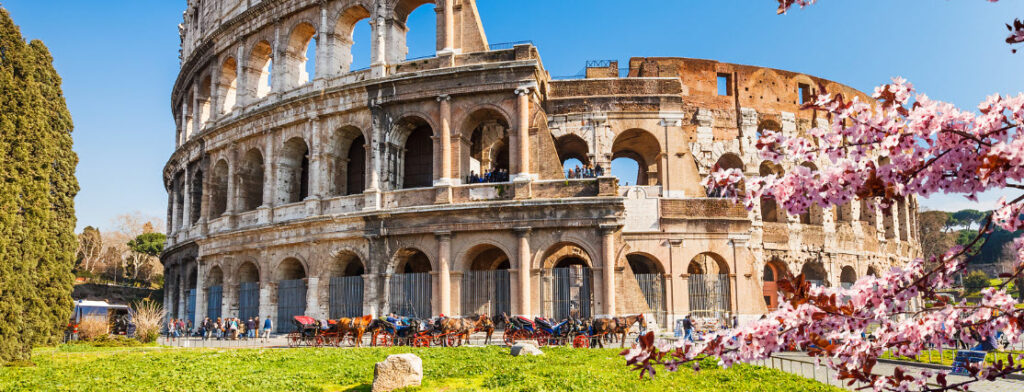
No trip to Rome is complete without a trip to the Colosseum. Stepping into the Colosseum is like stepping back in time to the days of ancient Rome where this magnificent structure was primarily used for gladiatorial contests, mock sea battle, and other spectacles that entertained the citizens of the Roman Empire. With a seating capacity of up to 50,000 spectators, it was a place where people from all walks of life would gather to witness the thrilling and often brutal events that unfolded within its walls.
The Colosseum boasts an impressive architectural design, characterized by its elliptical shape and towering stone walls. Constructed using travertine limestone, the amphitheater stands as a testament to the engineering prowess of the ancient Romans and its exterior showcases a series of arches, columns and intricate details that exemplify the grandeur of Roman architecture.
Inside, the Colosseum reveals a network of tunnels, chambers and passageways that once housed gladiators, animals and stage props. The arena floor itself, known as the “harena” or sand, was where the gladiators engaged in their battles. The seating tiers, divided into different sections based on social status, provided a clear view of the action unfolding below.
Despite centuries of weathering and various calamities, the Colosseum still stands as a powerful symbol of Rome’s glorious past. While some parts have been damaged or lost over time, the sheer scale and architectural magnificence of the structure continue to captivate visitors from around the world.
The Colosseum
Location: Piazza del Colosseo, 00184 Roma RM, Italy
9. Enjoy the views at Vittorio Emanuele Monument

Known as “Il Vittoriano” or “Altare della Patria” (altar of the fatherland), this remarkable structure commemorates the unification of Italy in 1861 and pays tribute to the country’s first monarch. Despite its association with Victor Emmanuel II, it is important to note that he is not interred within the monument; his final resting place lies in the Pantheon.
The Vittorio Emanuele Monument offers several notable sights to explore:
- A prominent feature is the magnificent bronze equestrian statue of Victor Emmanuel II, positioned prominently in front of the monument. Sculptor Enrico Chiaradia dedicated almost two decades to its creation.
- At the top of the building, you’ll find two quadrigas, each carrying a statue of the goddess Victoria—one on the left and one on the right.
- On the left side, there is a statue symbolizing Unity, crafted by Carlo Fontana. On the right side, a statue representing Freedom was created by Paolo Bartolini.
Beneath the statue of the goddess Roma, you will discover the “Tomb of the Unknown Soldier,” recognizable by the eternal flame and the two soldiers standing guard. This war monument honors the memory of unknown soldiers who lost their lives in various conflicts, including World War I.
The Museo del Risorgimento, accessible via a lift at the rear of the monument, offers insights into the history of Italy’s unification and primarily caters to Italian visitors.
Vittorio Emanuele Monument
Location: 00186 Roma RM, Italy
10. Spend some time at Teatro Marcello
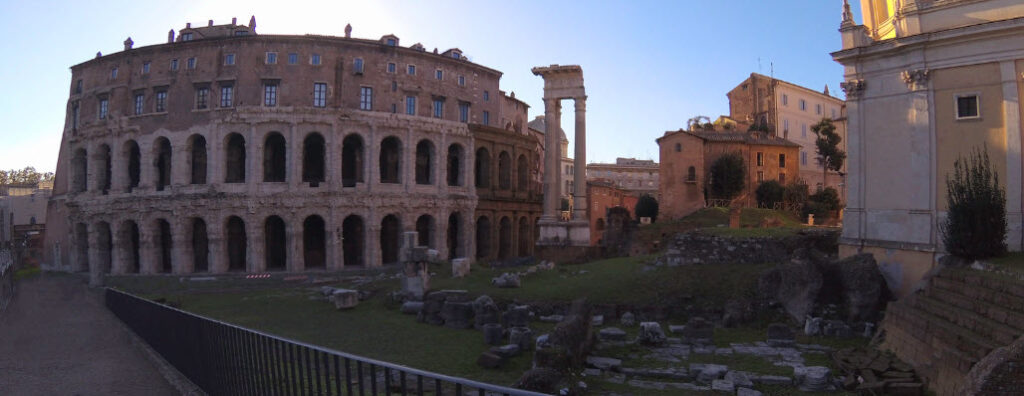
And finally, one of Rome’s hidden gems, the Teatro Marcello, offers a captivating glimpse into the city’s ancient history. Often referred to as the “mini Colosseum,” this theater could accommodate up to 20,000 spectators and was initially conceived by Julius Caesar and later completed by Emperor Augustus in 11 B.C., who dedicated it to his nephew, Marcellus.
The Teatro Marcello served as a prototype for the grander and more famous Colosseum that stands nearby and its architectural design and layout provided inspiration for the construction of the larger amphitheater. For several centuries, the theater remained an active venue for theatrical performances, captivating audiences with various spectacles and dramas.
Over time, as the Roman Empire entered its decline, the theater’s use as a performing arts venue diminished. However, it continued to serve the city in other capacities and underwent several transformations. Portions of the structure were repurposed into residential buildings and fortifications, preserving the ancient remnants within the fabric of Rome’s urban landscape.
Today, visitors can marvel at the well-preserved ruins of the Teatro Marcello and explore its intriguing history. The structure stands as a testament to the architectural genius of the ancient Romans and offers a fascinating glimpse into the entertainment and cultural practices of the time. Take a moment to imagine the grandeur of performances that once took place within its walls and appreciate its enduring legacy as a significant historical landmark in Rome.
Conclusion
And there they are, 10 things you can try if you find yourself in Rome with a day to kill. I would be pleased to know how this article helped you, and as usual, let me know of your experiences here.
Also, please do not hesitate to comment below if you have any questions, concerns, or corrections, or would like me to check anything else out for you.
Until next time.
Have fun
Paul

